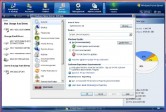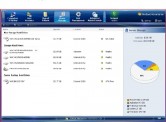WHS - Asylum Computers
Main menu:
Windows Home Server
Features at a Glance
• Automatic daily backups of your home PCs
• Restore lost files or an entire PC
• Access all your stuff on the home server from your networked PCs
• Share photos and home videos through a personalized Web address
• Organize your most important information in one central place
• Easy and quick setup
• Expandable storage space for future use
• Innovative third-
ANY business, regardless of its size, should invest in some basic minimums on the IT side of things. One important investment is a server -
Many small/sole businesses (with maybe one or two employees), see this as something that's all a bit too complicated or expensive -
There is, however, a Microsoft product called 'Windows Home Server' which, despite its name, can be ideal for small/sole-
Windows Home Server is designed to be as simple to manage as possible -
It stores stuff -
WHS is about safe, centralised storage of data, and that's it. It won't run big databases or Microsoft Exchange, but that's not really what one-
It automatically creates a series of 'shares' that are given friendly names such as 'Music', 'Pictures', etc. For use as a business device, you can easily remove these and create your own (maybe called 'Clients', 'Accounts', 'Personal' and so on).
Simple, effective, security
While a 'proper' server requires you to delve into Windows Active Directory, domains, and so on, WHS users can be added via a very simple administration screen, which asks little more than a user name, a password, and a choice of three levels of access rights to the different shared areas of the server's storage.
To connect your laptop or desktop PCs to the WHS server, you install a small 'WHS Client' on each machine, which ensures that WHS knows about your other computers.
Self-
Windows Home Server automatically organises all of its disk-
If, at a later date, you decided you wanted to replace that 100Gb drive with a 500Gb drive -
Duplicate data-
The only moving parts on most servers are the spinning disk drives. Inevitably, these are the parts that are most subject to failure.
One of the most effective answers to this is to automatically store TWO copies of everything on two different disk drives inside the server (This is called 'Mirroring' or RAID1). If one drive fails, you still have your data safe on the other one, and you can then replace the faulty device at your leisure while the server runs happily on one drive for a few days. (The chances of BOTH drives failing at the same time are miniscule).
Normally, setting up this kind of system demands that you purchase two identical drives, and carefully configure your server. Windows Home server, however, offers a very simple but effective version of this that takes all of the hassle out of the process. All you do is decide which areas of your data storage are vital, and tick a box for 'File Duplication'. WHS then ensures that a copy of your files is placed on one of the other disk drives (it doesn't matter which one -
This feature uses up double the amount of your disk space, of course, but remember you can just add another disk at any time. (External disk drives are fully supported, so you can buy an external drive, plug it in and see your extra space appear-
Automatic backups
WHS includes a feature that will automatically take full backup copies of the data on any laptop or desktop PC on your mini-
Remote Access
WHS includes a facility for remote access over the Internet. If you are away from the office or home, and suddenly find yourself in need of a piece of data or document, WHS lets you access your files from your laptop PC over the Internet. Needless to say, the system includes a range of security settings to protect your data, and the feature is not activated until you decide you want to start using it.
What DOESN'T it do?
WHS is designed to act as a simple but effective data-
Getting One
The WHS software can be purchased for use with existing hardware for about £65. This will support up to ten users. It took me about half an hour to set up, most of which was spent watching the installation process, and occasionally pressing 'Next'.
A number of manufacturers are now offering ready-
If you are a sole trader or a freelancer, keeping all your data on a laptop PC, then WHS is seriously worth consideration as a flexible, low-

